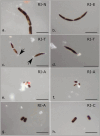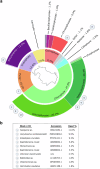Surface darkening by abundant and diverse algae on an Antarctic ice cap
- PMID: 40102384
- PMCID: PMC11920422
- DOI: 10.1038/s41467-025-57725-6
Surface darkening by abundant and diverse algae on an Antarctic ice cap
Abstract
Algal blooms play important roles in physical and biological processes on glacial surfaces. Despite this, their occurrence and impacts within an Antarctic context remain understudied. Here, we present evidence of the large-scale presence, diversity and bioalbedo effects of algal blooms on Antarctic ice cap systems based on fieldwork conducted on Robert Island (South Shetland Islands, Antarctica). Algal blooms are observed covering up to 2.7 km2 (~20%) of the measured area of the Robert Island ice cap, with cell densities of up to 1.4 × 106 cells ml-1. Spectral characterisation reveal that these blooms increase melting of the ice cap surface, contributing up to 2.4% of total melt under the observed conditions. Blooms are composed of typical cryoflora taxa, dominated by co-occurring Chlorophyceae, Trebouxiophyceae, and Ancylonema. However, morphological variation and genetic diversity in Ancylonema highlight the influence of regional endemism and point to a large and under-characterised diversity in Antarctic cryoflora.
© 2025. The Author(s).
Conflict of interest statement
Competing interests: The authors declare no competing interests.
Figures







Similar articles
-
The diversity of ice algal communities on the Greenland Ice Sheet as revealed by oligotyping.Microb Genom. 2018 Mar;4(3):e000159. doi: 10.1099/mgen.0.000159. Epub 2018 Mar 16. Microb Genom. 2018. PMID: 29547098 Free PMC article.
-
Seasonal cycles of snow algal blooms intensify surface melting on Antarctic ice shelves.Sci Rep. 2025 Jul 2;15(1):23139. doi: 10.1038/s41598-025-05129-3. Sci Rep. 2025. PMID: 40603364 Free PMC article.
-
Using metabarcoding to assess Viridiplantae sequence diversity present in Antarctic glacial ice.An Acad Bras Cienc. 2022 Feb 28;94(suppl 1):e20201736. doi: 10.1590/0001-3765202220201736. eCollection 2022. An Acad Bras Cienc. 2022. PMID: 35239797
-
How Does the Ocean Melt Antarctic Ice Shelves?Ann Rev Mar Sci. 2025 Jan;17(1):325-353. doi: 10.1146/annurev-marine-040323-074354. Epub 2024 Nov 25. Ann Rev Mar Sci. 2025. PMID: 39227348 Review.
-
Environmental constraints on life histories in Antarctic ecosystems: tempos, timings and predictability.Biol Rev Camb Philos Soc. 2006 Feb;81(1):75-109. doi: 10.1017/S1464793105006871. Epub 2005 Nov 17. Biol Rev Camb Philos Soc. 2006. PMID: 16293196 Review.
References
-
- Fyke, J., Sergienko, O., Löfverström, M., Price, S. & Lenaerts, J. T. An overview of interactions and feedbacks between ice sheets and the Earth system. Rev. Geophys.56, 361–408 (2018).
-
- Noble, T. L. et al. The sensitivity of the Antarctic ice sheet to a changing climate: past, present, and future. Rev. Geophys.58, e2019RG000663 (2020).
-
- González-Herrero, S., Barriopedro, D., Trigo, R. M., López-Bustins, J. A. & Oliva, M. Climate warming amplified the 2020 record-breaking heatwave in the Antarctic Peninsula. Commun. Earth Environ.3, 122 (2022).
-
- Purich, A. & Doddridge, E. W. Record low Antarctic sea ice coverage indicates a new sea ice state. Commun. Earth Environ.4, 314 (2023).
-
- Vignon, É., Roussel, M. L., Gorodetskaya, I. V., Genthon, C. & Berne, A. Present and future of rainfall in Antarctica. Geophys. Res. Lett.48, e2020GL092281 (2021).
MeSH terms
Grants and funding
LinkOut - more resources
Full Text Sources
Miscellaneous

